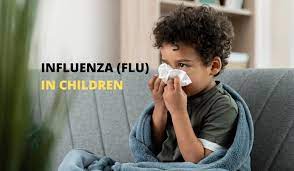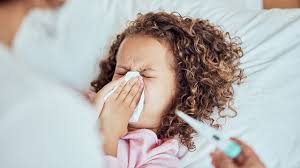
INDIANA – The Centers for Disease Control is warning that a drop in vaccinations in the U.S. may have increased flu deaths among children.
The CDC estimates that this season, there have been at least 35 million illnesses, 400,000 hospitalizations, and 25,000 deaths from flu. Seasonal influenza activity remains low nationally, but COVID-19 is elevated in most areas. As of September 13, the number of respiratory illnesses (fever plus cough or sore throat) causing people to seek healthcare is low nationally.

Influenza, or the flu, is a very contagious viral infection that affects the lungs’ air passages. It causes a high fever, body aches, a cough, and other symptoms. It’s one of the most severe and common viral illnesses of the winter season. Most children are ill with the flu for less than a week. However, some children have a more serious illness and may need to be treated in the hospital. The flu may also lead to lung infection (pneumonia) or death.
The CDC says nearly 200 children died from influenza-related illnesses this flu season and that most of the children who died were eligible for a vaccine but didn’t receive one. Three influenza-associated deaths have been reported this week for 197 deaths this season.
Flu viruses cause the flu. Flu viruses are divided into three types:
- Influenza types A and B. These two viruses cause widespread illness (epidemics) almost every winter. They often lead to more people needing to go to the hospital and more people dying from the flu. Public health officials focus on stopping the spread of types A and B. One reason the flu remains a problem is that the viruses change (mutate) often. This means that people are exposed to new types of viruses each year.
- Influenza type C. This type of virus causes a very mild respiratory illness. It rarely causes epidemics, and it does not have the severe public health impact that influenza types A and B do.
A flu virus is often passed from child to child through sneezing or coughing. The virus can also live for a short time on surfaces. This includes doorknobs, toys, pens or pencils, keyboards, phones and tablets, and countertops. It can also be passed through shared eating utensils and drinking. Your child can get the flu virus by touching something an infected person touched and then touching their mouth, nose, or eyes.
People are most contagious with the flu 24 hours before symptoms start and while symptoms are most active. The risk of infecting others often ends about days 5 to 7 of the illness. Because the flu can be spread before symptoms start, it’s easy to pick up a flu virus. This is especially true with children, who often touch many surfaces and then touch their mouth, nose, or eyes.
The flu is a respiratory disease that can affect the whole body. A child can become suddenly ill with any or all of these symptoms:
- Fever, which may be as high as 103°F (39.4°C) to 105°F (40.5°C)
- Body aches, which may be severe
- Headache
- Sore throat
- Cough that gets worse
- Tiredness
- Runny or stuffy nose
In some cases, your child may also have symptoms such as:
- Nausea
- Vomiting
- Diarrhea
Most children recover from the flu within a week. But they may still feel exhausted for three to four weeks.
It’s important to note that a cold and the flu have different symptoms:
| Cold symptoms | Flu symptoms |
| Low or no fever | High fever |
| Sometimes a headache | Headache in most cases |
| Stuffy, runny nose | Clear nose, or stuffy nose in some cases |
| Sneezing | Sneezing in some cases |
| Mild, hacking cough | Cough, often turning severe |
| Mild body aches | Severe body aches |
| Mild tiredness | Extreme tiredness (fatigue) that can last weeks |
| Sore throat | Sore throat in some cases |
There are prescription flu antiviral drugs that can treat flu illness; those should be started as early as possible and are especially important for higher-risk patients.

Treatment will depend on your child’s symptoms, age, and general health and on the severity of the condition. The goal of therapy is to help prevent or ease symptoms.
Treatment may include medicines such as:
- Acetaminophen. This helps lessen body aches and fever. Don’t give aspirin to a child with a fever.
- Antiviral medicine may help ease symptoms and shorten the length of illness. It can also lessen the chance of developing an ear infection from the flu. It may also help decrease other complications, including the need for hospitalization. The medicine is most useful if started within two days after symptoms start. But it may be started later if the child is having complications or is at high risk for them.
Antibiotics aren’t effective against viral infections, so they are not prescribed. They may be used, though, if your child has developed bacterial pneumonia. Otherwise, treatment focuses on helping ease your child’s symptoms until the illness passes.

As of May, the CDC says only 53 percent of children in the U.S. were vaccinated for the flu this season.
Because of other illnesses such as COVID-19 and RSV, the CDC says getting a flu vaccine is more important than ever to protect yourself and the people around you from the flu. Flu vaccines and other vaccines can be given at the same time. Talk with your healthcare provider about vaccines.






.png)













